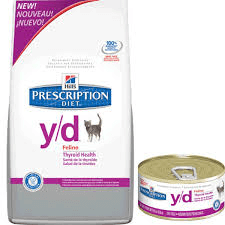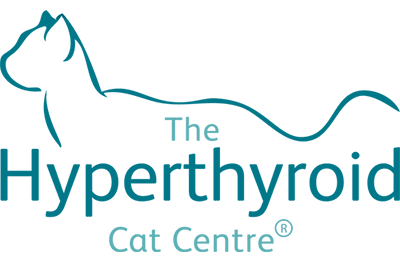Treatments
There are several treatment options for your cat’s hyperthyroidism. If you’re feeling a little unsure as to your best option, we’ll help you weigh them all up.
Your vet may have suggested several treatment options, since there are 4 to choose from. However, you probably want more information before you decide, and we do encourage you to research your options very carefully.
There are some significant advantages and disadvantages to consider, and we cover these in considerable detail in our free booklet, Hyperthyroidism in Cats. You can either download this or order it as a hard copy. For now, here’s an at-a-glance chart to highlight the key points, with some more detailed information below it.
Which feline hyperthyroidism treatment should you choose?
| Radioiodine | Medication | Surgery | Special diet | |
| Will it cure your cat? | Almost certainly | No (just controlled) | Almost certainly | No (just controlled) |
| One-off or lifelong treatment? | Almost always one-off | Lifelong | Often requires 2 or more operations | Lifelong |
| Do you administer the treatment? | No | Yes | No | Yes |
| Can the treatment be done at home? | No | Yes | No | Yes |
| Level of difficulty for owners | Initial care only | Medium | Initial care only | Potentially high |
| Is the treatment invasive? | No (injection only) | No (tablets/gel) | Yes | No (food only) |
| Can serious complications arise? | No | Yes | Yes | No |
| Will your cat need lifelong reviews? | No | Yes | No | Yes |
| Can hyperthyroidism recur? | 1% recurrence 3 years after RIT | It never goes away | Yes – 2 operations commonly needed | It never goes away |
| What are the cost considerations? | Cost effective over time | Costly over time | Could involve multiple high costs | Costly over time |
Radio-iodine therapy
Radio-iodine (or ‘radioactive iodine’) therapy is the gold-standard treatment for cats with hyperthyroidism. You can read our webpage detailing the full list of advantages, but in summary it’s your best chance of a low-risk, permanent cure for your cat. Unlike medication and diet, it’s designed to be a one-off treatment, and unlike surgery it is non-invasive.
Medication
Medication won’t cure your cat’s hyperthyroidism, but may keep it under control by preventing the over-production of thyroid hormone. Tablets are usually to be given once or twice a day, or a gel applied to the ear-flap, for the rest of your cat’s life. There are some benefits to this approach, but you may feel they are outweighed by the disadvantages:
- Giving tablets to cats is often stressful for both owner and cat.
- It’s easy to forget a tablet, or mistakenly administer it twice.
- Cats may learn to ‘store and spit’, so won’t get the treatment you think they’re getting.
- The drug can pass through the skin so it needs careful handling to prevent it passing through yours too.
- Temporary side-effects can include loss of appetite and vomiting (that’s your cat, not you).
- More serious side effects can also result, such as profound skin irritation, significant reduction in white blood cells, severe anaemia, and changes to the liver (the gel causes fewer side-effects, but can irritate your cat’s ears).
- The tumour will continue to grow, often requiring increasing doses of medication, which may introduce or aggravate more side effects.
- When not removed or destroyed, thyroid tumours can turn cancerous. Research indicates that whereas fewer than 2% of feline hyperthyroid tumours normally tend to be cancerous, 20% of them are found to be malignant in cats treated with medication for 4 years or more.
Surgery
Hyperthyroidism can be cured with surgery and, if successful, no further medication is required. However:
- Surgery is particularly risky for hyperthyroid cats – not just because they’re usually older, but because they’re likely to have a very fast heart rate.
- There is a risk of damage to the parathyroid gland, which is very close to the thyroid gland. Damaging this gland can cause calcium levels to plummet, which can eventually be fatal.
- To avoid damaging both parathyroid glands, your vet may decide to remove only one thyroid gland at a time. Since 75% of cases involve both thyroid glands, your cat would probably need a second operation, typically within 18 months. This increases both your costs and the risks to your cat.
- 20% of hyperthyroid cats will also have thyroid tumours within the chest, which are extremely difficult to identify and remove. To pinpoint them, a specialised imaging technique, called scintigraphy, is needed – but it isn’t widely available. It’s often only after the cat has had two operations, and yet is found to still be hyperthyroid, that thyroid tumours in the chest are suspected.
- Your vet may decide that your cat isn’t even a candidate for surgery because the risks are just too high.
Special low-iodine diet

Hills y/d Low Iodine Diet
Without iodine, the thyroid glands can’t produce thyroid hormone. So there is now a special low-iodine cat food, manufactured by a leading brand under very exacting conditions. However, this diet can only work if your cat will (a) accept and eat this special food, (b) eat absolutely nothing else, and (c) continue to do eat nothing else for the rest of its life. There are also problems with this treatment:
- If your cat ever refuses the diet (now or in the future, perhaps when very elderly or ill), or has access to even small amounts of other food, they will become hyperthyroid again.
- This diet is even more difficult when you have other cats, so you might have to feed it to all of your cats (which is a shame for them, and expensive for you)
- Your cat will face a very dull diet with no variety in flavours, and may eventually refuse it.
- It can take several months for the diet to have its full effect.
- Since this isn’t a cure, your cat’s tumour will continue to grow – which, research has suggested, could result in the tumour becoming cancerous.
- Research suggests that diets which are extremely low in iodine may have a negative effect on your cat’s immune system.
- Your cat will still need regular blood tests to check how well their condition is being controlled, which will mean ongoing vet bills.
- Over time, the cost of this special diet will mount up.

